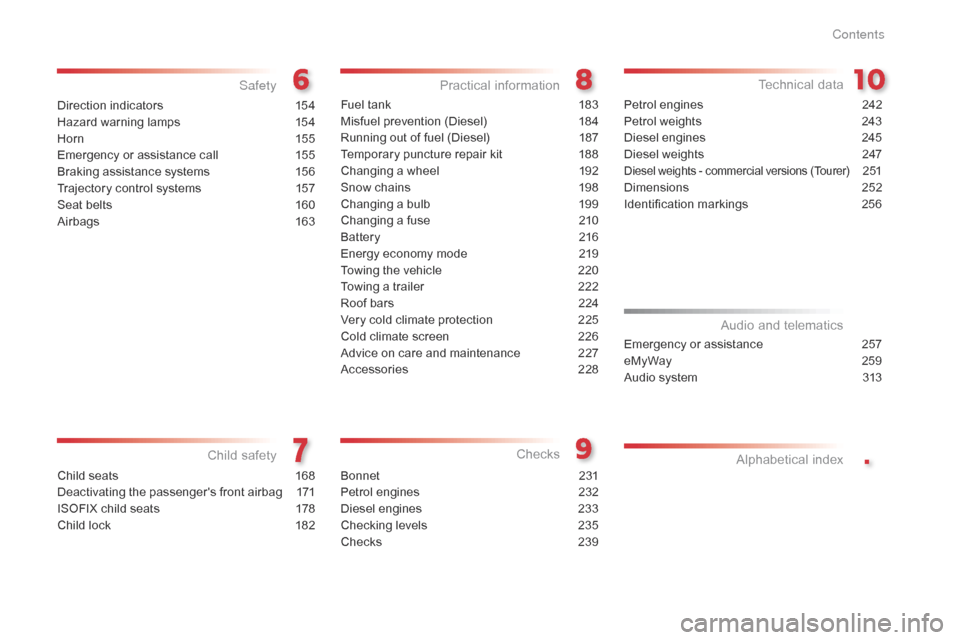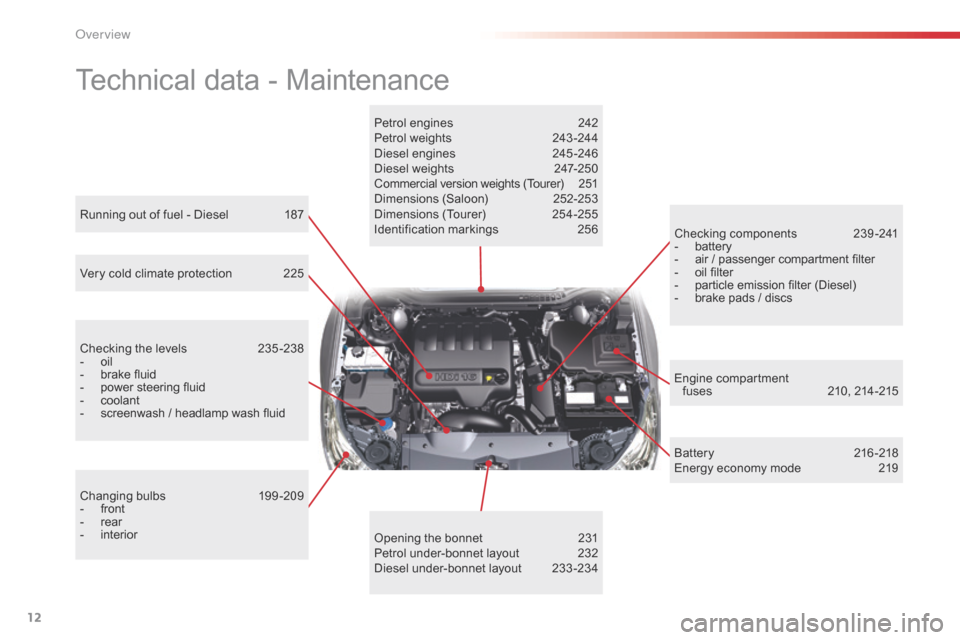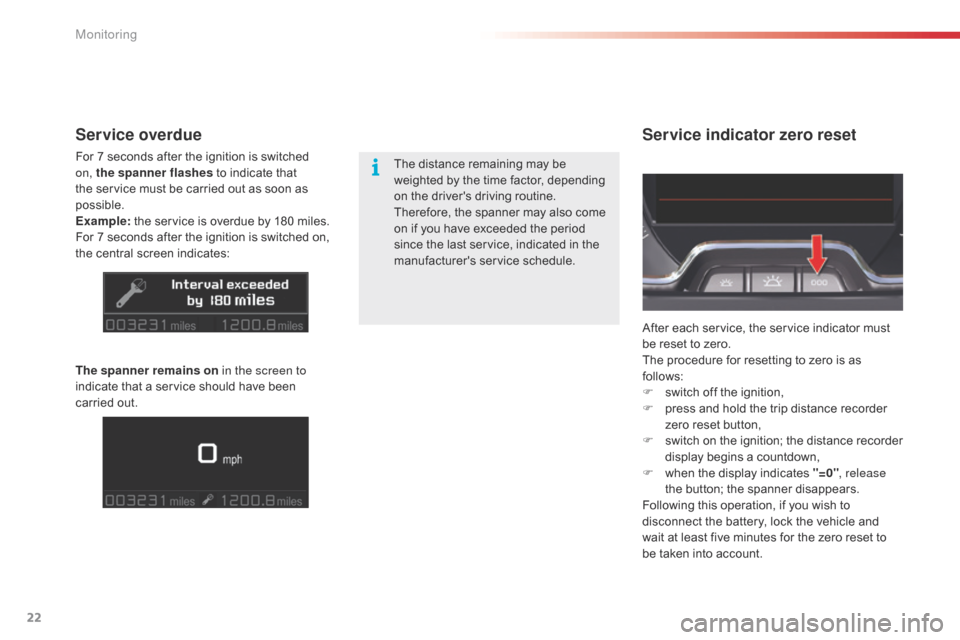weight Citroen C5 2014.5 (RD/TD) / 2.G Owner's Manual
[x] Cancel search | Manufacturer: CITROEN, Model Year: 2014.5, Model line: C5, Model: Citroen C5 2014.5 (RD/TD) / 2.GPages: 344, PDF Size: 12.9 MB
Page 5 of 344

.
Direction indicators 154
Hazard warning lamps
1
54
Hor n
15
5
Emergency or assistance call
1
55
Braking assistance systems
1
56
Trajectory control systems
1
57
Seat belts
1
60
Airbags
1
63Fuel tank
1 83
Misfuel prevention (Diesel) 1 84
Running out of fuel (Diesel)
1
87
Temporary puncture repair kit
1
88
Changing a wheel
1
92
Snow chains
1
98
Changing a bulb
1
99
Changing a fuse
2
10
Battery
2
16
Energy economy mode
2
19
Towing the vehicle
2
20
Towing a trailer
2
22
Roof bars
2
24
Very cold climate protection
2
25
Cold climate screen
2
26
Advice on care and maintenance
2
27
Accessories
2
28
Bonnet
23
1
Petrol engines
2
32
Diesel engines
2
33
Checking levels
2
35
Checks
23
9Petrol engines
2 42
Petrol weights 2 43
Diesel engines
2
45
Diesel weights
2
47
Diesel weights - commercial versions (Tourer) 2 51
Dimensions
2
52
Identification markings
2
56
Emergency or assistance
2
57
eMyWay
2
59
Audio system
3
13
Audio and telematics Alphabetical index
Child safety Practical information
Checks
Safety
Technical data
Child seats 1
68
Deactivating the passenger's front airbag
1
71
ISOFIX child seats
1
78
Child lock
1
82
Contents
Page 14 of 344

12
Technical data - Maintenance
Petrol engines 242
Petrol weights 2 43 -244
Diesel engines
2
45 -246
Diesel weights
2
47-250
C ommercial version weights (Tourer)
2
51
Dimensions (Saloon)
2
52-253
Dimensions (Tourer)
2
54-255
Identification markings
2
56
Opening the bonnet
2
31
Petrol under-bonnet layout
2
32
Diesel under-bonnet layout
2
33 -234
Running out of fuel - Diesel
1
87
Checking the levels
2
35 -238
-
oil
-
brake fluid
-
power steering fluid
-
coolant
-
screenwash / headlamp wash fluid
V
ery cold climate protection
2
25
Changing bulbs
1
99-209
-
front
-
rear
-
interior C
hecking components
23
9-241
-
battery
-
air / passenger compartment filter
-
oil filter
-
particle emission filter (Diesel)
-
brake pads / discs
B
atter y
21
6 -218
Energy economy mode
2
19
Engine compartment
fuses
21
0, 214 -215
over view
Page 24 of 344

22
Service indicator zero resetService overdue
For 7 seconds after the ignition is switched
on, the spanner flashes to indicate that
the service must be carried out as soon as
possible.
Example: the service is overdue by 180 miles.
For 7 seconds after the ignition is switched on,
the central screen indicates:
The spanner remains on in the screen to
indicate that a service should have been
carried out. The distance remaining may be
weighted by the time factor, depending
on the driver's driving routine.
Therefore, the spanner may also come
on if you have exceeded the period
since the last service, indicated in the
manufacturer's service schedule.
After each service, the service indicator must
be reset to zero.
The procedure for resetting to zero is as
follows:
F
s
witch off the ignition,
F
p
ress and hold the trip distance recorder
zero reset button,
F
s
witch on the ignition; the distance recorder
display begins a countdown,
F
w
hen the display indicates "=0", release
the button; the spanner disappears.
Following this operation, if you wish to
disconnect the battery, lock the vehicle and
wait at least five minutes for the zero reset to
be taken into account.
Monitoring
Page 56 of 344

54
Cancelling the
memorisation
With the tailgate in the intermediate position,
you can cancel the stored position:
F
M
ake a long press on push-button D .
The system emits a long audible beep.
F
R
elease the push-button D . The tailgate
will return to the fully open position at the
next use.
Electrical protection of the
motor
If the tailgate is repeatedly opened and closed
in quick succession, the motor can start to
overheat and then cut out, preventing opening
and closing of the tailgate.
Allow the motor to cool down for ten minutes
without opening or closing the tailgate.
Closing in manual back-up mode remains
possible.
To avoid risk of injury, make sure that
no one is in the vicinity of the boot while
opening and closing.
If the tailgate is carrying extra weight
(snow, bicycle carrier, etc.) there is a
risk of it closing under this load. Support
the tailgate or first unload the bicycle
carrier or clear the snow.
When using an automatic car wash,
don’t forget to lock the vehicle so as to
avoid any risk of motorised opening of
the tailgate.
Memorisation of an
intermediate position
You can store an opening angle for the tailgate:
F M anually or automatically move the tailgate
to the required position.
F
M
ake a long press on push-button D .
The system emits a short audible beep.
F
R
elease the push-button D .
Interrupting the opening /
closing of the tailgate
When the tailgate is being opened or closed
electrically, you can interrupt its movement
at any point by pressing push-button D , the
control A or button B .
You can then open or close the tailgate
electrically or manually, if necessary moving it
in the opposite direction to release it.
Locking/unlocking
With the vehicle stationary, this is carried out
using:
-
T
he remote control.
-
T
he key in a door lock.
-
T
he interior central locking/ unlocking control.
The boot automatically locks when the vehicle
is moving at a speed of over 6 mph (10 km/h),
even if automatic central locking is deactivated. It
is unlocked when a door is opened or when the
central locking button is pressed (at a speed of
less than 6 mph (10 km/h)).
Access
Page 170 of 344

168
Although one of CITROËN main criteria when designing your vehicle, the safety of your children
also depends on you.
General points relating to child seats
For maximum safety, please observe the
following recommendations:*
T
he regulations on carrying children are
specific to each country. Refer to the
legislation in force in your country. CITROËN recommends
that children
should travel on the rear seats of
your
vehicle:
-
re
arward facing up to the age of 3,
-
fo
rward facing over the age of 3.
-
i
n accordance with European regulations,
all children under the age of 12 or less
than one and a half metres tall must
travel in approved child seats suited to
their weight , on seats fitted with a seat
belt or ISOFIX mountings*,
-
s
tatistically, the safest seats in your
vehicle for carr ying children are the
rear seats,
-
a c
hild weighing less than 9 kg must
travel in the rear ward facing position
both in the front and in the rear.
Child safety
Page 177 of 344

175
Installing child seats secured using the seat belt
Seat position(s)Weight and indicative age of child
Up to 13 kg
(Groups 0 (b) and
0+)
Up to approx. 1 year From 9 to 18 kg
(Group 1)
From approx. 1 to 3 years
From 15 to 25 kg (Group 2)
From approx. 3 to 6 years
From 22 to 36 kg (Group 3)
From approx. 6 to 10 years
Row 1 Front passenger
(c) with
height adjustment (e) U (R)
U (R)U (R)U (R)
Front passenger (c) without
height adjustment (e) U
UUU
Row 2
ou
ter rear (d) UUUU
Centre rear (d) (f ) UUUU
In conformity with European law, this table shows you the possibilities for the installation of universally approved child seats (a)
using a seat belt,
depending on the weight of the child and the seating position in the vehicle.
7
Child safety
Page 183 of 344

181
Positions for fitting ISOFIX child seats
I UF: Seat position suitable for installation of an I sofix Universal " For ward facing" seat attached
using the top tether.
IL- SU: Seat position suitable for installation of an I S
oFI
X Semi- Universal child seat, either:
-
r
ear ward facing fitted with an upper strap or a support leg
-
f
or ward facing fitted with a support leg,
-
a s
hell fitted with an upper strap or a support leg.
To attach the upper strap, refer to the "ISOFIX mountings" section. Weight of child/
Age given as a guide
Up to 10 kg (group 0)
Up to approx. 6 months Up to 10 kg
(group 0)
Up to 13 kg (group 0+)
Up to approx. 1 year 9 to 18 kg (group 1)
Approx. 1 to 3 years
Type of ISOFIX child seat Shellrearward facing rearward facing forward facing
ISOFIX size class F G C D E C D A B B1
ISOFIX universal and semi-universal
child seats can be installed on the outer
rear seats IL- SU
* IL- SU IL- SUIUF/IL- SU
*
T
he ISOFIX shell, fixed to the lower rings of
an ISOFIX seat, occupies two rear seats.
In conformity with European law, this table shows you the possibilities for the installation of ISOFIX child seats to seats in the vehicle fitted with ISOFIX
mounting points.
For ISOFIX universal and semi-universal child seats, the ISOFIX size class, defined by a letter from A to G
, is shown on the child seat to the right of
the ISOFIX logo.
Remove and stow the head restraint
before installing a child seat with a
backrest on a passenger seat. Refit the
head restraint once the child seat has
been removed.
7
Child safety
Page 224 of 344

222
Towing a trailer
Your vehicle is primarily designed for transporting people and luggage, but it may also be used for towing a trailer.
Side wind
F Take into account the increased sensitivity to side wind.
Driving advice
Cooling
Towing a trailer on a slope increases the
temperature of the coolant.
As the fan is electrically controlled, its cooling
capacity is not dependent on the engine speed.
F
T
o lower the engine speed, reduce your
speed.
The maximum towed load on a long incline
depends on the gradient and the ambient
temperature.
In all cases, keep a check on the coolant
temperature.
We recommend the use of genuine
CITROËN towbars and their harnesses
that have been tested and approved
from the design stage of your vehicle,
and that the fitting of the towbar is
entrusted to a CITROËN dealer or a
qualified workshop.
If the towbar is not fitted by a
CITROËN dealer, it must still be
fitted in accordance with the vehicle
manufacturer's instructions.
Driving with a trailer places greater demands
on the towing vehicle and the driver must take
particular care.
Distribution of loads
F Distribute the load in the trailer so that the heaviest items are as close as possible to
the axle and the nose weight approaches
the maximum permitted without
exceeding
it.
Air density decreases with altitude, thus
reducing engine per formance. Above
1
000 metres, the maximum towed load must
be reduced by 10
% for every 1 000 metres of
altitude.
Refer to the "Technical data" section for details
of the weights and towed loads which apply to
your vehicle. F
I
f the warning lamp and the
STOP warning lamp come on,
stop the vehicle and switch off
the engine as soon as possible.
Practical information
Page 245 of 344

243
* The weight of the braked trailer can be increased, within the GTW limit, on condition that the GV W of the towing vehicle is reduced by the same amount; warning, towing with a lightly loaded towing vehicle may have an adverse effect on its road holding.
Weights and towed loads (Saloon) in kg
Petrol engine 1.6i VTi 1201.6i THP 155
Gearbox Electronic gearbox systemAutomaticManual
Model code:
RD... 5FS- 8/P
5FV-5FN/A 5FV-5FN/8
Unladen weight 1 4251 5151 471
Kerb weight 1 5001 5901 546
Gross vehicle weight (GV W) 2 0182 026 2 065
Gross train weight (GTW) 3 3183 526 3 565
Braked trailer (within GTW limit)
-
o
n a 10% or 12% slope 1 300
1 5001 500
Braked trailer* (with load transfer within GTW
limit) 1 570
1 7101 730
Unbraked trailer 750750750
Recommended nose weight 6469 70
The GTW and towed load values indicated apply up to a maximum altitude of 1 000 metres; the towed load mentioned must be reduced by 10 % for
each additional 1 000 metres of altitude.
The speed of a towing vehicle must never exceed 100 km/h (approx. 60 mph) (comply with the legislation in force in your country).
High ambient temperatures may result in a reduction in the per formance of the vehicle in order to protect the engine; when the ambient temperature is
higher than 37 °C, limit the weight towed.
10
Technical data
Page 246 of 344

244
Petrol engine1.6i VTi 1201.6i THP 155
Gearbox Electronic gearbox systemAutomaticManual
Model code:
RW... 5FS- 8/P
5FV-5FN/A 5FV-5FN/8
Unladen weight 1 4981 534 1 503
Kerb weight 1 5731 609 1 578
Gross vehicle weight (GV W) 2 1332 200 2 167
Gross train weight (GTW) 3 4333 7003 667
Braked trailer (within GTW limit)
-
o
n a 10% or 12% slope 1 300
1 5001 500
Braked trailer* (with load transfer within GTW
limit) 1 600
1 7901 790
Unbraked trailer 750750750
Recommended nose weight 657473
The GTW and towed load values indicated apply up to a maximum altitude of 1 000 metres; the towed load mentioned must be reduced by 10 % for
each additional 1 000 metres of altitude.
The speed of a towing vehicle must never exceed 100 km/h (approx. 60 mph) (comply with the legislation in force in your country).
High ambient temperatures may result in a reduction in the per formance of the vehicle in order to protect the engine; when the ambient temperature is
higher than 37 °C, limit the weight towed. *
T
he weight of the braked trailer can be increased, within the GTW limit, on condition that the GV W of the towing vehicle is reduced by the same
amount; warning, towing with a lightly loaded towing vehicle may have an adverse effect on its road holding.
Weights and towed loads (Tourer) in kg
Technical data